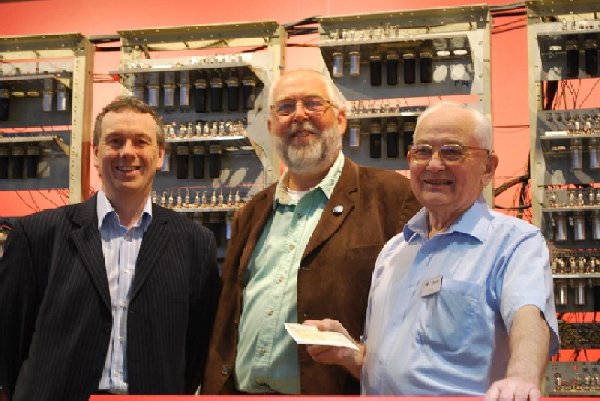
Peter Thompson - President ISACA Northern England Chapter,
Ray Butler - Past President of the Chapter,
George Roylance – volunteer in Baby replica project
| Resurrection Home | Previous issue | Next issue | View Original Cover | PDF Version |
Computer
RESURRECTION
The Bulletin of the Computer Conservation Society
ISSN 0958-7403
Number 55 |
Summer 2011 |
| Top | Previous | Next |
Science Museum - Tilly Blyth
The Museum has submitted a successful first stage bid to the Heritage Lottery Fund for a new gallery entitled of Making Modern Communications. The second stage of the bid will be submitted in September 2011. Substantial content around the computer is anticipated. A section currently called The Cloud is scoped to include narratives from EDSAC and LEO, via the competing cold war supercomputers BESM 6 and the CDC 6600, to the PC and the Internet. This major new gallery will be on the second floor of the museum and will open in 2014. CCS members are active in the development of the new gallery.

|
Peter Thompson - President ISACA Northern England Chapter, |
Manchester Baby - Cat Rushmore
George Roylance, Baby volunteer, took delivery of a cheque for £150 on behalf of the Baby Volunteers and MOSI on 6th May 2011. This was a donation from ISACA, to help support the Baby volunteers and maintain the replica. ISACA is a professional body supporting people working in the field of IT Governance. The Northern Chapter hosted a conference in the city which was attended by 250 ICASA members from 29 countries around the world. They took the opportunity to visit MOSI on 22nd March and were very impressed by the demonstration of the replica Baby. The hard work put in by the volunteers to maintain and demonstrate the machine is evidently very much appreciated by MOSI visitors, as well as by the Museum.
EDSAC Replica - David Hartley and Chris Burton
The BCS has appointed David Hartley and Kevin Murrell as trustees of the EDSAC Replica charity. Jack Lang (a Cambridge entrepreneur) is to be company secretary and is assisting Hermann Hauser in fundraising. The appointment of a project manager is still under consideration.
Technical investigations by Chris Burton and Bill Purvis have continued. The main achievement is a simulation of the whole logic of the machine including substantial representations of areas where no prior documentation exists. This convincingly executes short programs with valuable diagnostic waveform graphics. The logic diagrams represented will provide a definitive base for conversion into electronic circuits, and those will then have to be mapped onto physical chassis. An engineering drawing for the basic EDSAC chassis has been produced for evaluation.
A meeting at TNMoC on 3rd May was held to brief representatives of the volunteers group there on our planning for the project so far, and to learn their views on feasibility and time-scales. As well as explaining the technical work, we demonstrated the loaned chassis from Cambridge University, an experimental breadboard of two EDSAC gates and an inverter showing the kind of signals and gate delays to be expected, and another working demonstration of a 256-bit wire acoustic delay line in an adding loop as an indication of how we might implement the main EDSAC store.
A discussion about timescales indicated that once the project got under way, there would be so much further design and investigation work to do that the start of construction of the replica could not take place for about 15 months. This should allow enough time for planning for finding a build site and setting up any support facilities.
Short visits have been made to an engineer who worked on EDSAC in 1950, and to another engineer with some knowledge of the circuit designs. So far no new information has resulted from either visit. Searching for components has continued and substantial purchases have been made while items are still available. We still desperately need many hundreds of B9G valve-holders, the type used for the EF50 series of valves.
ICT 1301 - Rod Brown
The 1301 project is currently continuing work on the data capture interface, and the forthcoming open day.
We have always worked in association with teams investigating other hardware and emulation. Such a project is the 1900 emulator which has been a subject of an article in Resurrection 51. The ICT 1301 Project has assisted them in the past with conversion of old paper tapes to computer files for the emulator. However we are now proud to discover that a small paper tape converted at the project in Kent has been discovered to be from an ICL 1905 machine in Putney Bridge House South from about the early 1970′s. This is the executive code required to drive a 1905 emulator as well as a snapshot of the UNIDAS disc operating system produced for the 1900 range. As such it is quite an important piece of digital archaeology.
Further on this theme we have been in discussion with another group about the history of core store and its application. This has also given us a lot of pleasure as the group has now published a web page describing a project for a small 32bit core store complete with source files and building instructions. This project is powered by an Arduino chip. All the details are published and on-line at www.corememoryshield.com.
The chosen timing of the launch of the site was the 11th May 2011 to highlight the 60th anniversary of the granting of the patent of core store and its use in Project Whirlwind.
We feel these two incidents confirm the project’s belief that creating a public presence on the web promotes the spread of information and encourages younger generations to learn about and explore historic computing technology.
News about the project can be found on the dedicated project website www.ict1301.co.uk.
CCS Website 1 - Dik Leatherdale
Some time ago, we were asked whether we could include details of a small computer museum in every edition of Resurrection. We considered the matter and concluded that this might be the thin end of a rather large wedge. So it was decided to make a list of all the UK museums of which we were aware and put it on a page of our website ( www.computerconservationsociety.org/museums.htm). Each one has a brief overview and a web address for further information. If you know of any more, please let us know.
ICL 2966- Delwyn Holroyd
We reached another milestone in the project last month. All the CUTS logic tests now pass with no errors. The purpose of the CUTS logic test suite is to diagnose faults that would prevent a machine from booting, however unfortunately ours still doesn’t! The CUTS manual advises that in this situation, “Expert engineering attention is required”!
The boot process gets further when the machine is cold, but we are concentrating on solving the issue when it is warmed up as this should be more straightforward. Unfortunately the system console is not properly set up for diagnostic access when the problems start which makes it very hard to figure out what′s going on. Various ideas are being tried out but progress is slow as we are being forced to study a lot of source code.
Elliott 401 - Chris Burton
A start has been made on a review of the future of the project by discussions with Rod Brown who has made contributions to establishing generic volunteer roles. In discussing the technical issues of the project we believe we can give much impetus to the work if we provided a semiconductor-based pseudo drum in place of the real rotating drum. This would enable the real drum to be commissioned separately and later, and allow commissioning of the computer logic to proceed without depending on the vagaries of behaviour of the real drum. Designs will be worked out in the next few months.
We really need a few more volunteers to work on this project. An understanding of computer design and electronics would be valuable, though not necessarily of valve electronics. That can be picked up on the job.
Analytical Engine - Doron Swade
The legal process to establish Plan 28 is well advanced. (Plan 28 is the project name taken from the most evolved of Babbage’s schemes for the Analytical Engine).
The first phase of the project is the detailed examination of the technical drawings in the archive held by the Science Museum at Wroughton. Practical access to the archive will be using digitised images of the drawings and the first phase of the process will start in earnest when digitised images are available.
The Science Museum has expressed its intention to digitise the whole Babbage archive. This is very welcome news. We continue to await developments.
The Hartree Differential Analyser - Charles Lindsey
We are still hampered by lack of access to the parts of the machine in the Museum′s offsite storage. In particular a clutch for the 2nd integrator is not available and we plan to bypass it temporarily so as to be able to generate sine waves and demonstrate drawing a circle.
We now understand the art of adjusting the torque amplifiers somewhat better and we have been able to obtain some genuine “Cuttyhunk” linen thread for the first stage. We have a possible source of tubular cotton braid for the second stage amplifiers (seemingly American Hi-Fi enthusiasts use it for sleeving).
We have removed the two huge solenoids that operate the clutches from the machine, and have been testing them offline. We were a little worried about the double-cotton insulation of their windings, and with the shortness and fragility of the “pigtails” where they emerge from the windings. The pigtails have been stabilised and the solenoids now appear to operate satisfactorily, and are ready to be refitted to the machine. Measurements of force vs. displacement have been made; the force increases markedly when the armature is fully in, and things should be adjusted so they operate in this region. Thus it may be necessary to shorten the Bowden cables connecting them to the clutches, since they appear to be right on (or beyond) the limit of their range of adjustment. A transformer and a box to contain it have been obtained and are being fitted, after which the limit switches which cause the solenoids to trip out will need to be rewired.
TNMoC - Pete Chilvers
In May a new gallery was opened at the National Museum of Computing dedicated to a replica of the wartime Tunny machines. Tunny was a recreation of the German Lorenz cipher machines which, once Colossus had helped find the key, was used to decrypt the message. Encrypted messages on paper tape were fed in to Tunny and the translation was output in plain German text. The recreation has now been completed providing another link in the chain of replica machines which can demonstrate the process of message interception from receipt to the provision of raw intelligence.
A video may be found at (dead hyperlink - http://eandt.theiet.org/videos/index.cfm) courtesy of the Institution of Engineering and Technology.
CCS Website 2 - Alan Thomson
We have enhanced our presence on the web - and we now have a shorter address to get to our web pages - start with ccs.bcs.org. This domain address takes you to our main page on the BCS website. From there you can navigate to our pages on the BCS website and to sections on our own CCS website.
Our BCS pages include initial pages on historic computers. We hope to grow the content on these pages (please contact the CCS website editor if you can help prepare more).
Our CCS sections include news items, latest details of forthcoming events, information on restoration projects and working groups, useful links, and electronic copies of Resurrection past and present.
Have a look for yourself by going online and try navigating around. Have a browse around, and save bookmarks for pages you might wish to look at periodically (such as the CCS home page or the CCS events page).
DEC - Kevin Murrell
PDP11 and IRIS
Peter Vaughan has now managed to copy and preserve the flight replay data that was previously only on tape.
The part of the IRIS ATC system that was not well documented and used bespoke systems rather than standard DEC PDP11 peripherals was responsible for replaying recorded radar data back into the system. This was becoming increasingly unreliable and there was some risk of losing the replay data.
The hope is to construct a new disc based device to replay the radar data stream back into the IRIS system.
PDP8
Thanks to a new contact at the Computer History Museum in California, we now have the circuit diagrams for the paper tape interface in our rack mounting PDP8. This was an interim system designed for both the PDP8 and PDP7. Until now we have not had any diagrams.
North West Group
In Resurrection 50 we reported that, after 17 years as secretary to the North West Group of the CCS, Ben Gunn had decided to retire from his post, handing over to Gordon Adshead.
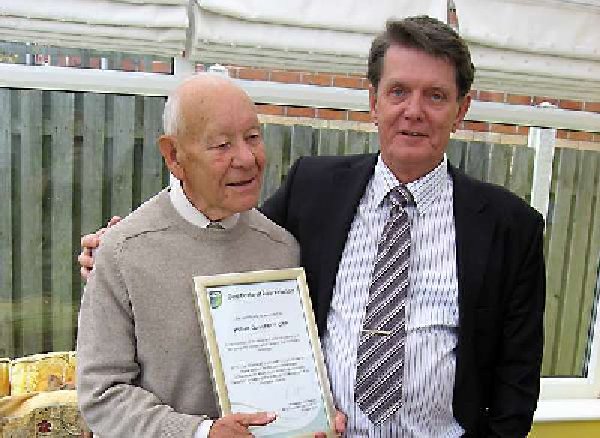
|
Ben Gunn, Tom Hinchliffe and the certificate |
In May of this year a presentation of a Certificate of Appreciation from the BCS was made to Ben, together with a whisky decanter from all his friends in the North West Group. Group Chairman Tom Hinchliffe led a small party to Ben’s home in Penistone for the presentation which, we are given to understand, was followed by a less formal but convivial gathering on nearby licensed premises! Ben’s enthusiasm, hard work and long service is greatly appreciated by all his colleagues.
North West Group contact detailsChairman Tom Hinchliffe: Tel: 01663 765040. |
| Top | Previous | Next |
Connoisseurs of computer errors would have needed a “heart of stone not to laugh” when, after less than a day’s operation in March, the much- publicised countdown clock for the 2012 Olympic opening ceremony failed. Less remarked upon however was a report that, had the clock been allowed to continue, anybody depending upon it would have been an hour late. Somebody forgot to allow for British Summer Time! A classic!
Spare a thought then for the sponsors and makers of the six tonne clock. OMEGA, the well-known manufacturer of quality timepieces, no doubt paid handsomely to have their name associated with this fiasco.
-101010101-
In Resurrection 53 we reported that a collection of Alan Turing’s papers, previously the property of the late Max Newman, had failed to sell at auction. The collection has now been purchased by the Bletchley Park Trust following a public appeal and with the help of two large and generous donations by the National Heritage Memorial Fund and by Google. Following conservation, they are expected to go on display later this year.
-101010101-
Still with Bletchley Park, Chief Executive Officer of the Trust Simon Greenish has announced his impending retirement after a term of five years. It has been five years during which the Trust has made impressive progress for which Simon must be very proud. A search for a replacement CEO is already under way.
-101010101-
The last manufacturer of mechanical typewriters, Messrs Godrej & Boyce of India, ceased production in 2009 and has recently announced that remaining stocks are now down to 500. It is a mark of the swift ascendancy of the word processor that as recently as 20 years ago some 50,000 typewriters were sold annually by this single company.
-101010101-
The Centre for Computing History in Haverhill, Suffolk has announced that it plans to relocate to Cambridge. Funds are being raised to enable the move to take place. No date is yet committed.
-101010101-
Readers will be glad to learn that the BBC’s Domesday project has been reborn on the World Wide Web. Originally released in 1985 to great acclaim but few sales, the Domesday project was based on Laserdisc technology and ran on the then ubiquitous BBC Micro. With the passing of the years, the technology became obsolete and it was thought that the material had become inaccessible. Much of it has now, however been triumphantly rescued and can be found at www.bbc.co.uk/history/domesday.
-101010101-
Following the publication of Resurrection 54 and its article on IBM card punches, CCS member and ex-IBMer John Edwards confessed to having rescued an IBM 026 punch from a skip in 1985. John was seeking a good home for his artefact which was soon identified. In due course it will be making its way to a certain barn in darkest Kent where it will proudly stand beside an ICT 1301 by the name of Flossie.
CCS member John Hughes recalls that an IBM 029 took the part of the central computer in the 1974 John Carpenter science fiction film Dark Star.
-101010101-
We have discovered a private collection of vintage ICL computers and other artefacts assembled by CCS member Pete Wooledge. Most, but not all, items date from the late 1980s onwards. A large collection of documentation is also present.
Although there is no public access to the collection, it is all catalogued on a website at www.vintage-icl-computers.com which is worth a visit. Thanks to John Panter for the information.
-101010101-
Further to the discovery of the existence of the Prestige 1900 Series of kitchen tools in Resurrection 54, it has been pointed out that such items might well have been purchased in a hardware store in 1952. Sorry, couldn’t resist.
-101010101-
The National Museum of Computing at Bletchley Park has recently introduced a modest admission charge which is separate from that of Bletchley Park itself. Visitors may pay for both or either.
-101010101-
The BCS has recently announced that the winner of the 2011 Lovelace Medal is Dr Herrmann Hauser. The Lovelace medal is awarded to individuals in recognition of their contributions to the advancement of Information Systems. Dr Hauser is best known for the BBC Micro but he is now very much involved with the CCS project to recreate EDSAC. The Society congratulates him on this signal honour.
-101010101-
In Resurrection 48, we reported that, as part of the celebration of Pegasus’ 50th birthday, Simon Lavington would be revising and republishing his book The Pegasus Story: A history of a vintage British computer.
The 50th birthday came and went but, as members will be all too aware, certain difficulties were encountered along the way. Unhappily the project has had to be shelved, at least for the time being. However copies of the first edition, once thought to have been destroyed, are still available in a few bookshops and from web-based book retailers.
Meanwhile Simon, having completed his magnum opus on Elliotts (see below) has now started work on editing a booklet to commemorate Turing’s 100th anniversary in 2012. The provisional title is Alan Turing and his Contemporaries. Written by the great and the good of the Society, it is intended to include chapters on developments in Manchester, Cambridge, Bloomsbury, Teddington, Hammersmith and Borehamwood as well as chapters on Turing himself.
-101010101-
To Cambridge at the end of June for an event entitled Sir Maurice Wilkes - An Affectionate Tribute. With the speakers being Martin Campbell-Kelly, David Barron and David Hartley (all well known to CCS members) together with Andrew Herbert, Andy Harter and Don Gaubatz (founding member of the Computer History Museum), the day was obviously going to be an assured success. But it was better than successful, it was outstanding. Some attention was paid to Sir Maurice’s many achievements. But what came over was a portrait of a distinguished and much respected figure held in the very highest esteem by everybody who worked with him and yes, held in enormous affection too. A fitting and very moving tribute to a great man.
By the time you read this, a video of the proceedings should be available at sms.csx.cam.ac.uk/institution/CL.
| Top | Previous | Next |
This reviewer’s high opinion of the new publication is undoubtedly shared by the overflowing audience of computing professionals who attended the recent overview presentation given by Professor Lavington to the Computer Conservation Society confirming the widespread interest and regard for his new work.
In many ways that gathering on 21st April 2011 was like a college alumni reunion; the collective recollection being that Elliotts was, in its day, known as “The finest industrial university in the country”.
The book Moving Targets details the history of Elliott Brothers in 1947 through to the last vestige of those families of Elliott’s computers in GEC Computers in the 1990s.
The title of the book Moving Targets is surely a reference to the recurring technical and marketing themes described by the book. Taken literally, the initial computing work in Elliotts was for gunnery targeting and required a novel design of self-directing antenna system. There followed intensive computation of “glint” radar signatures acquired from flying aircraft.
Then, over the years, there were revolutionary and incremental advances in computer architecture, implementation technology, business goals and government programmes.
Ever-changing business targets, resulting from the turmoil of the reorganisation of the whole British computer industry in the late 1960’s, meant staff came to the same office each day, but company names seemed to change quicker than the seasons!
For this reviewer, who joined Elliotts as a new graduate in 1964 and transferred to a “sister” GEC company in the US two decades later, the book not only provoked moving reminiscences; but also explained puzzling fragments of personal history which had seemed to lie as unresolved puzzles in my mental archives.
One such unknown was why my university thesis project on stacked tunnel-diode counters was of such interest to my Elliott’s interviewer - Simon’s book explains that the Computer Research Lab had also experienced difficulty getting reliable results in similar device configurations!
Perhaps the most fundamental attribute of a sound history book is demonstrable accuracy. By drawing on many varied documents and people sources, the author has been able to cross-check the details. Certainly, this reviewer can personally attest to a precise correctness for two of the decades covered by the book. Having worked alongside many of the staff who provided material about Borehamwood and Dunstable, there is no doubt that the whole book is exceptionally well researched to a superb accuracy.
Although Elliotts (unlike some other UK computer companies) had no formal historian, this retrospective compilation certainly achieves that same high level of completeness. Indeed, by being able to take a broader strategic view, hindsight probably provides improved balance between detail and longer term trends.
In an anthropological sense, the author has taken pains to chart the life cycle of the Elliott “society”, to compare it with parallel tribes and to identify those recurrent and trending factors that led to success, survival, relocation and demise.
Simon does this gently, simply presenting the events in Elliotts. Elsewhere he leaves the reader to see how such situations kept repeating over the decades.
He has sliced the material to cover separately the interrelated aspects of technology, architectures, people, organisations, markets and businesses. In a very few places there is a sense of duplication, but only where it is required to reframe the material and refocus the reader to relevant viewpoint.

|
Elliott 152 computer in 1952 |
Although there are no surviving photos for the very first machines, the book contains many interesting pictures. The oldest photograph of an Elliott’s computer in 1952 evokes a powerful image of its size and apparent wiring nightmare.
The Elliott 152 pioneered plug-in glass printed circuit boards with plated- through holes and deposited resistors.
However, reliability of the 152 computer was poor, the customer’s (Admiralty’s) defence budget was reduced and the project was not followed through.
From this beginning developed many series of Scientific/Engineering/Defence computers and forked several major industries.
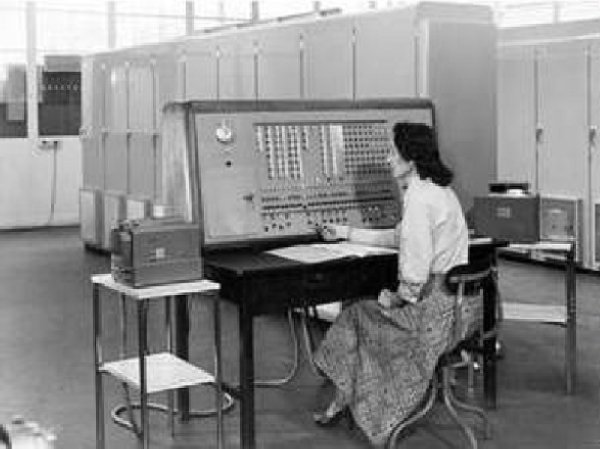
|
Dina Vaughan in 1956 at console of Elliott 405 |
One early fork at the end of 1958 was the creation by Dina Vaughan of a separate software development company. This reflected the emergent need for software intellectual property and actual programs to be re-usable across more than one design of hardware. She remained an active director of that company until 1996.
One of Dina’s projects in Elliotts was to implement their first computer-based payroll system. This reviewer was told how some Borehamwood employees felt disadvantaged after the in-house phone directory was once sent to all staff inadvertently sorted by salary instead of the customary last name!
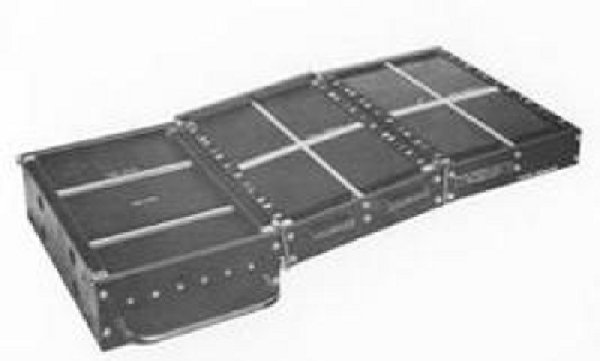
|
Fold-out construction of the Elliott 920M defence computer |
Because it was under the same Elliott’s company umbrella, defence/military versions of computers were implemented with instruction sets compatible with their non-rugged counterparts. This allowed reuse of software. Those defence projects could also utilize early host/target development techniques. The 900 Series had many implementations.
The 920M used wire-wrap back connections. Many of the labour-force were mothers who worked the evening shift or whose children were grown.
I recall that a misguided attempt to increase production quality by an RAF pilot in proper dress uniform showing those staff a film of a high-technology fighter aircraft using its low-level terrain-following radar was counter-productive. The staff became terrified that if they made a wiring error that “very nice young pilot” would crash! QC had to explain repeatedly that assembly errors would be detected by rigorous in-house testing.
In 1956 Elliotts entered into a cross-marketing agreement with NCR (National Cash Register Corp of Dayton, Ohio). In addition to the initial objectives to allow each company access to broader markets (i.e. Elliotts gained commercial sales, NCR could sell its customers advanced digital computers), some common software development tools were developed. This agreement lasted for over 10 years.
In his description of the corporate history, Simon documents how successive Elliott managements wrestled with the problem of how to grow the business to long-term viability, given the relatively small size of the UK market for computers.
He details -
Students of computer architectures will find a trove of side-by-side comparisons. Detail is provided of: the selection of word lengths (e.g. reducing word-length to 12-bits for lightweight military applications), numbering systems (e.g. position of implied binary-point), and addressing techniques such as the advent of the B-modifier and indexing.
Periodically staff moved from Elliotts and its successors to join/start competitor companies or as part of the brain drain to N. America. The author details these events properly without bias. Almost as an aside, there is mention of the disruption and soul-searching caused by these skill losses. This reviewer considered leaving when my annual review (as a computer design manager) was capped by GEC head office requiring my salary to not exceed that of the managing director of the washing machine company!
Some senior staff, such as John Bunt who had made an enormous design and management contribution to several series of computers, simply left because the effects of the workplace-stress on their personal well-being became unacceptable.
I was reminded of a minor marketing coup when Simon explained the Elliott 4100 and the English Electric Series 4 ranges; Engineering blueprints for EE Series 4 always retained a nomenclature like “4130” which did support the (perhaps apocryphal) explanation that Alan Fraser got wind of the English Electric planned use of models named 4130 etc, so he deliberately chose the titling of the Elliotts 4120 & 4130 to clash. Pre-empting their usage of the name just before the Series 4 launch, English Electric was delayed by having to reprint all its marketing and exhibition literature.
In comparing Elliotts with other UK computer companies, there might have been some in the 1960’s & 70’s who looked beyond the day-to-day pressures and became aware that not all the competitors could possibly survive. In Chapter 13 Mergers, Takeovers and Dispersals the author explains the demise of the UK computer industry.
It is sad reading. Surely no-one at the time envisaged that no non-defence computer manufacturer in the UK would (perhaps with hindsight it is could?) survive.
In his chronology of Elliott’s engineering computers, Simon concludes with the last scientific computing architecture: the GEC Series 63. Again (as before with the Elliotts/NCR cross-licensing agreement) part of the business goal became to gain market share in the US and in the commercial markets. This reviewer remembers the excitement when the Series 63 RISC-design running OS4000 won head-to-head benchmark performance evaluations submitted by leading UK academic researchers.
The GEC ethos demanding every company to be profitable certainly ensured that the sum-of-the-parts must be profitable. But it is this reviewer’s opinion that, by eliminating risk to the corporate bottom-line, strategic risk-taking was starved of essential investment. So it was impossible to allow the whole to nurture revolutionary advances even in a few carefully chosen sectors.
Thus the outstanding lineage of Elliotts ended. The costs of developing the related computer businesses were more than GEC would permit with its unyielding demand for month-by-month profitability.
On page 495 we read “.. money was being poured into the development of a new small computer (the Series 63) .... I stopped all work on the new small computer immediately.” - Paul Rayner.
It is perhaps ironic that Roadrunner (the internal codename for the Series 63 project) is a long-legged ground-dwelling bird in the cuckoo family!
As I understand it, the demise of GEC came through reckless acquisitions. New executives behaved like military ashore on a spree free of the overbearing drill sergeant. GEC, having avoided risk for decades, died on a binge.
![Elliott’s staff at presentation by Professor Simon Lavington. [21-April-2011]](images/images55/res55f.jpg)
|
Elliott’s staff at presentation by Professor Simon Lavington. |
| Top | Previous | Next |
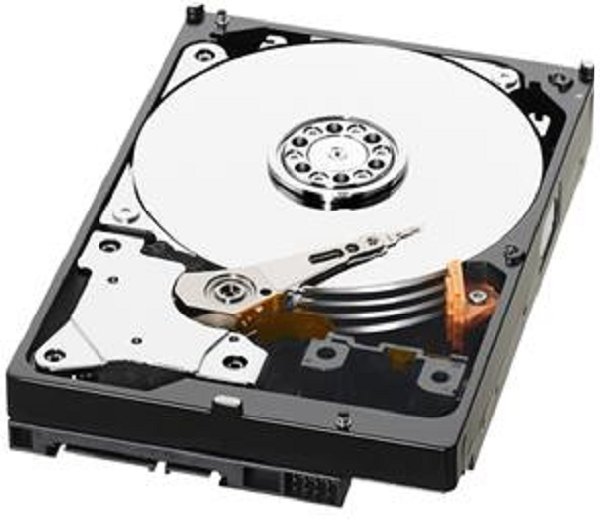
|
Have you ever stopped to think about hard disc drives? Where have they come from? Where are they going? In short the evolution of the hard disc drive (HDD). In case you think they are far removed from you, I counted 13 in my home and they are the ones I know about. Here is a picture of one of the latest.
Where did it all start? The immediate predecessor to the HDD was the magnetic drum. It was realised that by slicing a drum up into thin platters and placing the recording surface on the top and bottom of the platters a greatly increased surface area would be created in the same space. Of course this had been done before, when the phonograph turned into the gramophone.
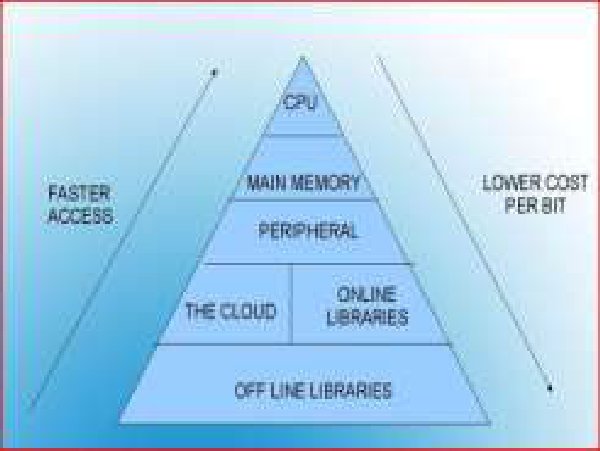
|
The Storage Hierarchy |
Drums were sometimes used as the main and only storage of the computer. They mapped onto the top level of the storage hierarchy. At this level cost is sacrificed in order to get the fastest access time. Nowadays on-chip CPU caches occupy this level.
Below this is the main memory level which is typified by dynamic random access memory (DRAM), typically 2 to 3GB, in the case of the 32 bit Windows operating system.
Then we deal with the peripheral level where HDDs are used to provide fast random access to large volumes of customer data. Below this, the cloud is a new area where data can be stored and retrieved after internet delays. Online libraries are devices such as Robotic Tape library silos or optical disc jukeboxes where the software can access a particular file after automatically loading the correct media.
Lastly, we see the off-line library at the bottom level. Here media must be manually located and loaded. At this level access time has been completely sacrificed to get the lowest cost per bit. There are many variations of the storage hierarchy and today HDDs can be found at all but the top two levels. Redundant HDDs can be used for off line storage and mounted via a caddy when required.
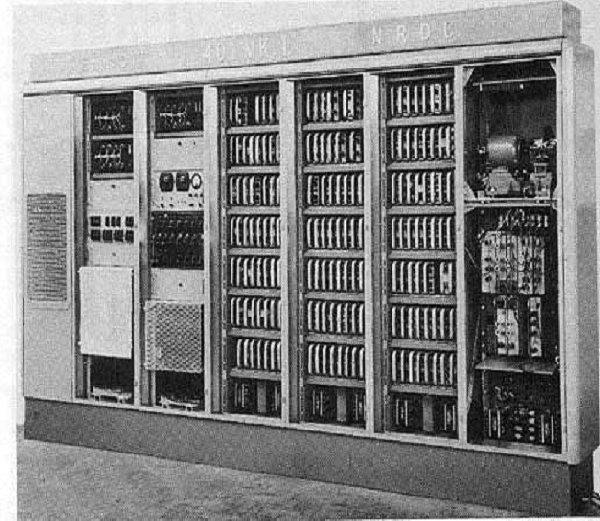
|
The 1953 NRDC-Elliott 401 |
The first use I can find of an HDD is in the NRDC-Elliott 401 disc store which was exhibited in 1953 (Thanks to Alan Thompson who told me about it). The disc had a single 9″ platter which can just be seen in this photograph. It is to the right of the motor which turned the disc at 4600 rpm.
In any HDD you need read and write heads to record and playback the data. In this case there were 11 of them which were fixed in position. This arrangement gave 11 tracks. Only eight of these were data, the other three were used for addressing and timing.
So how much capacity did this drive have? Well a mere 8KB was available. It was expandable by doubling the fixed heads. Unfortunately the product only lasted eight months when Elliotts devolved the design back to a drum. Who knows what went wrong?
The first successful commercial HDD was the IBM 305 RAMAC (Random Access Method of Accounting and Control) which came along in 1956. Over 1,000 were sold in the following five years.
This HDD had a 50 platters spinning at 1,200 rpm. This time there was an arm that moved in and out of the platters and vertically up the stack of platters (see the photo below). This HDD is an order of magnitude away from the Elliott in engineering terms. The arm holding the head weighed three lbs and was driven pneumatically reaching half the tracks in only 600ms. A second optional arm could also be fitted. The head on the arm floated above the ferrite coated aluminium platters at a height of 800 micro inches, held there by a jet of air. The air jet was replaced in later HDDs by a head with an aerofoil base which literally flies above the platter. Incidentally, as the platter had a diameter of 24″ this would be termed a 24″ Form Factor (FF).
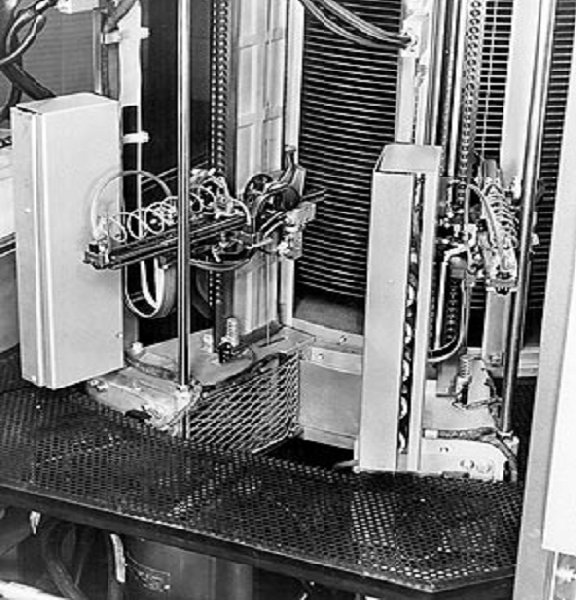
|
The 1956 IBM RAMAC HDD |
So what capacity did you get for a piece of equipment weighing a ton? The answer is 10MBs. This represents a 600 times capacity increase in three years. The RAMAC was used for peripheral storage in the storage hierarchy model. Rather than store partial calculations it was used to store customer data as is indicated by its name.
You may have noticed that the RAMAC spun slower than the Elliott disc. Access time was very important at the CPU level of the storage architecture, less so at the peripheral level. Of course, the mass of all those platters had a lot to do with it. Conversely, capacity and cost per bit are important at the peripheral storage level. I am sure that the cost per bit was much less on the RAMAC compared to the cost of 600 ENRDC-401s!
The RAMAC started a revolution in storage. Data needed to be available in large quantities online with fast random access times. Previously, data was stored in serial media with slow access times such as paper tape, punched cards and magnetic tape often requiring operator intervention.
Manufacturers quickly appeared to fill this new need for disc drives. In 1960 there were about 15 suppliers. This grew rapidly to 150 or more by the 1980s. A rapid series of mergers and acquisitions then occurred with many companies going bankrupt or dropping out as they could not compete with the economies of scale of their larger competitors. By 2004 there were only nine suppliers left. Three of them were Japanese companies who had managed to survive in the HDD market from the 1960s.
Now there are only three suppliers left to service the world. They are Western Digital, Seagate and Toshiba.
Returning to the topic of Form Factors (FFs), these started out very large like the RAMAC at 24″. Gradually, they became smaller as recording densities increased. 8″ HDDs were, for a time, widespread in mainframes, before the introduction of the 51/4″ FF. This FF is still used in today’s CD/DVD drives. Since the 1990s the 31/2″ drive replaced the 51/4″ and has since shipped in the greatest volume. HDD shipments grew exponentially in the early years leading followed by the growth of 2.5′′ HDDs in the last 10 years mainly used in laptops.
The 3TB HDD at the start of the article has a 31/2″ FF. However, the race for smaller drives continued giving rise to the 1.8″ and 1″ FFs used in MP3 players, iPods and the like. They really are remarkably small, as shown here. The 1.8′′ FF represents an important growth area and its use is spreading to mobile phones and motor cars. The 1′′ Form Factor is now obsolete.
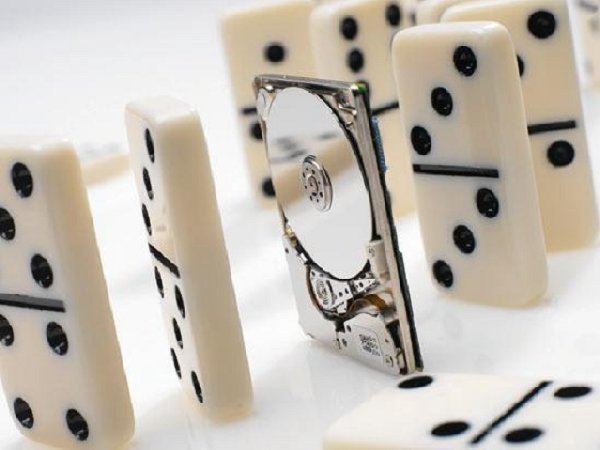
|
How were ever smaller FFs made possible? The answer is by dramatically increasing the areal density of the recordings. Areal density is the product of tracks/inch and bits/track.
The RAMAC had wire wound heads. These gave way to thin film heads and the process of size reduction was under way. Whilst this was being achieved inductive heads gave way to magneto restrictive effect heads. These were further evolved using so called giant and colossal magneto-restrictive effects. The magnetic media and heads started to use advanced materials to increase their coercivity (ease of magnetisation). Clean room technology was mandated to allow the head flying heights to decrease rapidly. Thus heads could be engineered to be smaller simultaneously allowing recorded bits along the track to be correspondingly small. This had the effect of increasing capacity as well as increasing the data rate of the device without having to spin it faster. The track widths were also decreasing at the same time permitting tracks to be recorded closer together. Increased track density at the same time as increased bit density drove a doubling of areal density every two years.
All was not rosy, as error rates rose alarmingly. Simple schemes of parity would not suffice. Mathematically sophisticated error correction codes had to be employed. For many years HDDs have been designed to make errors. The designers traded off improved error correction algorithms against increased areal density error rates. Thus today’s HDDs routinely correct data errors by hardware before they reach the consumer The semiconductor revolution has permitted complex chip designs to offer these sophisticated algorithms in hardware at a low cost.
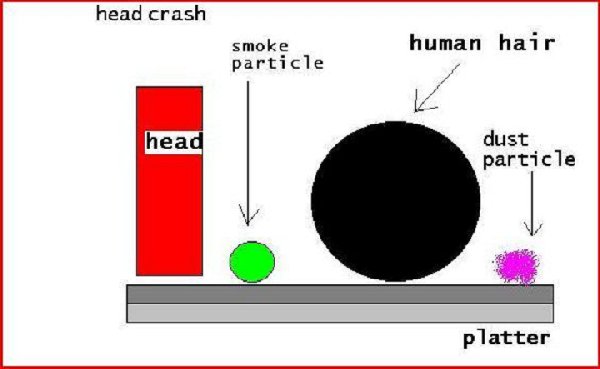
|
Head Gap Relative Size |
The reduction in flying height the new heads permitted led to a need for clean room technology. Why was there a need to be able to filter out smaller and smaller particles from the air surrounding the heads? Well the diagram here shows the relative sizes of heads and common contaminants which caused head crashes. IBM invented the Winchester architecture for HDDs. It includes a case with a filtered access to the ambient air to allow for pressure equalisation. The filter maintains the standard of cleanliness. This clean room technology has migrated from HDD assembly lines to surgical theatres where air curtains maintain increasingly sterile zones. The surgeon and staff are free to move through the clean zones whilst sterility is assured at the operating table.
Winchester design included the general layout of the heads / arms / platter / hub motor placement still found in today’s HDDs.
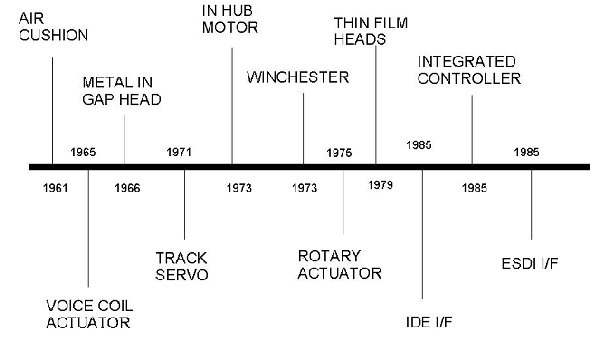
|
Technology Timeline 1 |
There have been many improvements in disc drive technology that chart the evolution of the HDD in the early years.
The air cushion is the aerofoil shaping of the bottom of the heads so that air passing beneath them lifts the head off the platter. The height is determined by the shape of the surface and the rotational speed. Heads used to land and take off from unused areas of the media. Then they were retracted to parking areas by back EMF from the motors during shut down. However in flight head crashes did occur, due to external shock and contaminants. Needless to say that having suffered a head crash the drive was now heavily contaminated and further head crashes were all too likely.
The heads even suffered from stiction where the heads stuck to the platter surface preventing the platter from rotating when the HDD was powered up. Many adaptations of the media ensued with special coatings including diamond coatings and lubrication. Today heads are retracted over a ramp which lifts them clear from the media
Servo systems deserve discussion. On the timeline above is the introduction of servo tracks. These were designed to keep the heads aligned over the data tracks by negative feedback loops. As track widths and spacings reduced this became more and more difficult. Heads soon could have offsets applied to assist data recovery. The problem was to have a hub motor that gave no wobble and arm positioning that was accurate enough. Much work was done in these areas. Today the head arm contains piezoelectric elements for coarse adjustment and the same on each individual head for fine adjustment, both controlled by their own servos.
Another similar issue is thermal compensation and a special track is often incorporated to allow for temperature compensation. Barometric pressure is also an issue. In Johannesburg the air at 5000ft is 25% less dense than at sea level. The heads fly correspondingly lower. This too is compensated for automatically.
I now turn to the actuator which positions the head over the correct track. We have seen fixed heads which avoided delays whilst positioning the heads. The RAMAC linear head arm moved both horizontally between tracks and vertically between platters. The vertical access time was eliminated by having a dedicated head for each surface. The size of the actuator was initially reduced by using voice coil actuators. These were first used in loudspeakers and introduced into floppy discs by Shugart and then made it into the HDD. They allowed the Winchester architecture to be introduced. These in turn were replaced by the more accurate radial actuators still used today.
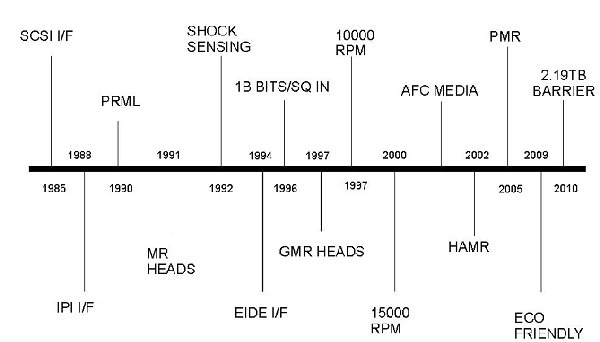
|
Technology Timeline 2 |
In the last 20 years further advances have been made. Before I deal with these, a slight diversion into the 2.19TB limit. This is not a disc drive limit but a DOS limit. Rather like Y2K, the number of blocks on a track is limited by the size of the field allocated in DOS based operating systems. There are workarounds such as adaptors, splitting a 3TB disc into two drives, a new motherboard and operating system changes. Generally if you keep a small boot disc then your data disc can be large. New PCs later in the year should be fully capable. It is something to watch out when buying 3TB or greater HDDs for existing PCs.
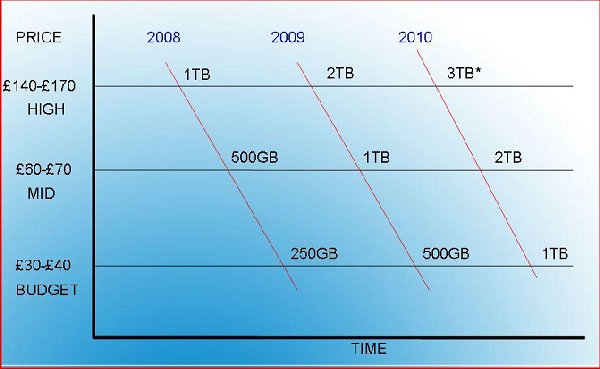
|
PC Internal HDD Price Points |
Whilst on the subject of PCs it is interesting to look at the retail price structure brought about by increasing areal density. The basic price of disc drives does not decrease. Rather you can buy a larger capacity disc for the same money. Three price points are maintained as shown in the adjacent chart.
MR heads were soon followed by GMR heads. The trend of increasing areal density was so rapid that Kryder, a Seagate Chief Technical Officer, stated Kryder’s law. Think of Moore’s Law for transistors. They both predict a doubling of densities every two years (Moore’s law initially stated a doubling every 18 months but was amended in its early days). But could Kryder’s Law be maintained?
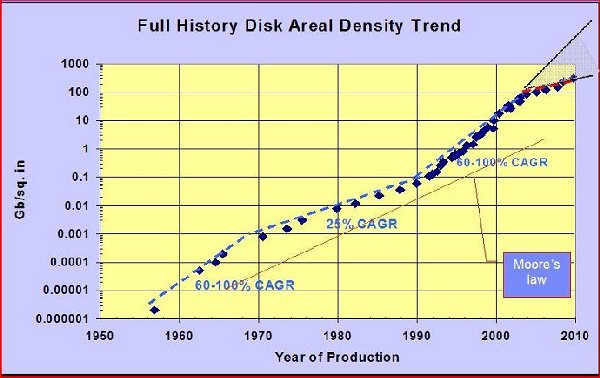
|
The preceding graph shows that in recent years the rate of growth of areal density has dropped off. Why is this?
For magnetic discs the first of the limitations of physical laws came in the so called superparamagnetic limit. As the tiny bar magnets used to record bits reduced in size there comes a point where adjacent bits and thermal excitation can cause bits to randomly reverse. Enough of this and error correction is overwhelmed. Reaching the limit has been delayed by two strategies. The platter media was constructed with two opposing recording layers which gave mutual reinforcement (AFR). This worked well for horizontal recording and delayed the introduction of perpendicular magnetic recording. However, when capacities are expected to double every two years advances do not last long.
The next approach was to record perpendicularly to the platter surface (PMR). This meant that only the tip of the bar magnet was taking up space thus increasing recording bit density. In the vertical plane, bar magnet length could be maintained. Of course head design had to be modified to detect the smaller features and the change in signal response. This is the current technology.
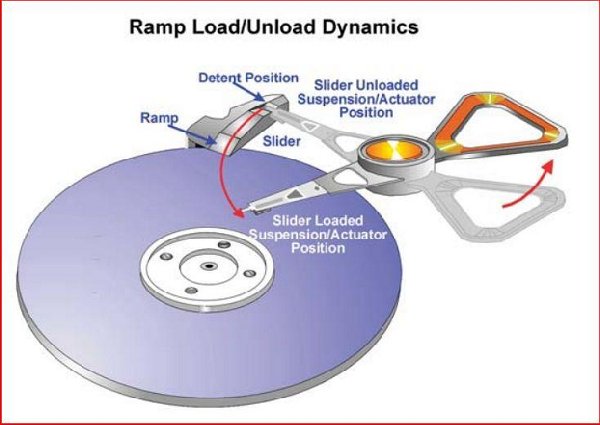
|
Ramp Technology |
HAMR refers to heat assisted magnetic recording. Here a laser heats the bar magnet during magnetisation relaxing the media and making it easier to magnetise and then retain the magnetism when cooled. This improves detection rates. This technology is available in the laboratory and is reckoned to give a 100 times improvement in recording density. It may have to be used with patterned media. Here the granules of magnetic media are all uniform and lead to lower noise levels when reading, perhaps a 10 times improvement. The superparamagnetic limit is delayed once again.
With these technologies in the wings a future disc drive with 100 times the current capacity seems achievable. This represents an increased lifetime for HDDs of 12 years taking us to 2023. But the laws of physics will win out eventually and have already broken Kryder’s law. In the mid-2020s we will come up against the physical limits once again. This time the technology as we know it may have to be replaced by something altogether different.
If you think this is the only problem, the same is happening with ever reducing transistor sizes. Sooner or later quantum effects rule and you don’t know if you have stored a one or zero or both. Both means it is effectively random. Again, Moore’s law is already broken. A similar time scale is on the cards though 3D chips or graphene may allow us, once again, to delay the physical limits expected to be reached in the mid 2020s.
The world′s data that is stored has increased 10 times in the last 5 years and is expected to reach 1,800 exabytes by the end of the year. We all know the drivers: HD streaming of video, paperless office, music, the cloud, message logging, everything in the cloud. Everyone has access to large volumes of data with fast response times.
Much of the world’s economy rests on these high growth rates. So what will happen? Will the evolution of HDDs continue or will there be a revolution and replaced by a new industry?
Will the answer for disc drives be spintronics where the spin of an electron represents a bit? A technology also exists where atoms can be placed (written) and subsequently read. The word “IBM” was written in this way as a demonstration. Although data capacities would be enormous, write data rates are only about 6Hz. Holographic optical recording has also been touted but is only expected to give 50 times current capacities.
An old favourite replacement technology is solid state drives (SSDs), effectively a RAM simulating an HDD. Obviously, access times are much improved but the cost per bit limits their use. They can be found on high end laptops, ipads and on some mainframes. So far they have not caught up with HDDs and have their own barriers.
From Windows Vista onwards, a pen drive (flash memory) called ReadyDrive by Microsoft, could be used to store operating system routines. This has had some success at speeding up PC boot times by about 10%. Now the disc drive manufacturers have introduced hybrid drives. There are two types of hybrid drive which couple an HDD with a buffer store inside an HDD. The first is flash based and non volatile while the second contains DRAM with battery backup, is volatile and so must be backed up to the HDD. The latter is more like an SSD and is faster in use, but not during boot when it must be loaded. The flash variety is faster during boot but not in normal operation compared to the DRAM version. Both are faster than HDDs alone.
Recently the drive manufacturers have included extra functionality called adaptive memory which decides for itself, independent of operating system, what to cache and what to write to HDD. This is an example of another long term trend of function moving out from centre to the periphery. Hybrid drives are also able to save power and noise by spinning up and down. With a 4GB cache only 10% of operations require the drive for laptop users. However all this spinning up and down may have an adverse effect on the mean time between failures (MTBF) Thus HDD suppliers have already hedged their bets against SSDs.
Will heat assisted (laser) magnetic recording work and/or patterned media fulfil their potential? Will one of the competing technologies make a breakthrough? One thing is sure that the ability to constantly reduce costs and store everything in ever greater volumes is under threat.
I await the future with interest and there is not long to wait!
Editor’s note: Neil Macphail joined English Electric Leo Marconi in 1964 and retired from Fujitsu after 38 years in Mainframe Input / Output Systems. During that time he managed the development of Disc, Tape and Communications products. He is remembered for leading the 2900 CAFS hardware projects and was also the ICL project liaison manger to Seagate Technology for Baracuda Disc Drives for several years. The author can be contacted at neil.macphail@bigfoot.com.
| Top | Previous | Next |
In May 2011, David Hartley and Kevin Murrell visited the Computer History Museum (CHM) in California to speak about the CCS and Prof. Sir Maurice Wilkes. They took the opportunity to visit the new CHM exhibition Revolution and to establish links between the CHM and the CCS in the UK.
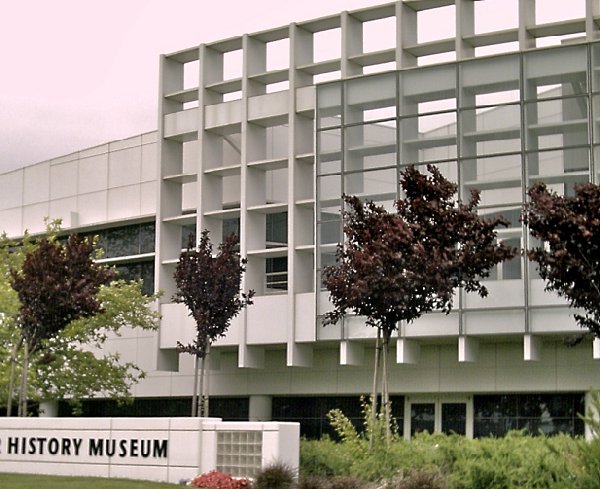
|
The Computer History Museum |
Situated some 30 miles south of San Francisco in the town of Mountain View, The Computer History Museum is housed in an impressive modern building that was originally the home of Silicon Graphics. Mountain View is in the heart of Silicon Valley and is quite the industry town, with Google, HP and Microsoft Research as major employers.
CHM is a very well funded establishment with a prestigious board of trustees, many full time staff and a well established volunteer programme.
The Computer History Museum grew out of the now long-gone Computer Museum in Boston. Maurice Wilkes gave a lecture at the opening of that museum in September 1979.
Kevin gave a presentation on the CCS and its activities at a “brown-bag lunch” meeting. This is a relatively short daytime lecture particularly aimed at those working in the valley. He used the Harwell Dekatron computer as an example of how CCS projects come about and are progressed, as well as describing the other CCS projects in play. Kevin gave an overview of the EDSAC replica project and described the progress of collecting original information about the machine and Chris Burton’s experiments into possible alternatives to mercury delay line storage.
CHM’s chairman, Len Shustek, then led an extensive question and answer session with the audience. CHM uses a very efficient technique of providing the audience with postcards and asking them to write the questions out during the lecture. These question cards are then sorted and used by the meeting chairman to interview the speaker. The questions ranged from the difficulties of finding original components, the search for younger volunteers and reconciling the differing views of museum professionals and enthusiastic engineers.
After an evening reception, David Hartley and CHM’s CEO John Hollar gave a joint presentation to the guests on the life of Prof. Sir Maurice Wilkes. Rather than give a formal lecture, this was arranged as a conversation between David and John about Sir Maurice’s life. This was planned thoroughly beforehand of course and worked very well: John would lead with a question and give David the chance to answer fully and include photographs. The questions ranged from Sir Maurice’s early life and interest in electronics, the US trip to the Moore School in 1946, the building of EDSAC and the establishment of the Computer Lab, through to his productive “30 years of retirement” and his time in the US with DEC.
David’s presentation included a short video of Sir Maurice at the opening of the Boston museum - something we plan to show at the October CCS lecture.
The CHM has recently opened a huge new exhibition called Revolution: 2000 years of computer history. The 25,000 sq ft exhibition comprises an orientation theatre, 19 galleries and five mini-theatres. It is an exhaustive collection of almost 90,000 objects, with the first galleries each anchored by a single iconic machine. Understandably, the exhibition has a predominantly American bias, and for the British visitor the choice of iconic machines is sometimes quite a surprise!
Unlike similar museums in the UK, very few of the artefacts are shown working, but are displayed instead “out of reach”. Again unusual for British museums, the artefacts are generally not shown in context - that is using the machine to describe the applications they ran or systems they supported. CHM has spent $19,000,000 on the new exhibition including a new café, lobby and restoration workshops. Potential visitors to the exhibition are advised to allow at least a day to take everything in.
The US edition of Babbage’s difference engine is still on loan to CHM and has its own place in the museum. It is demonstrated several times each week and the team running the machine are testing and running new algorithms. It is hoped that the display surrounding the machine will be improved when the loan to CHM is extended.
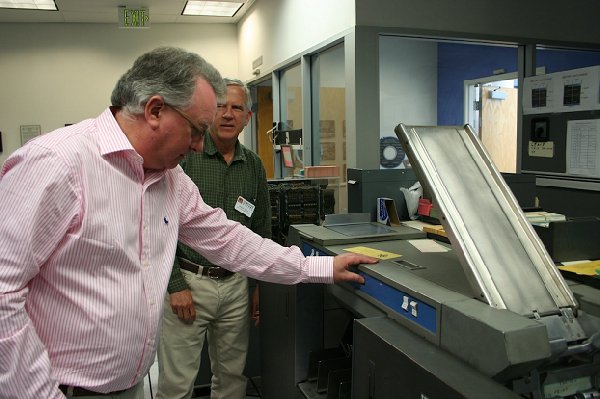
|
Kevin Murrell starts the IBM 1401 card reader |
The museum is currently running two machine restoration projects - a DEC PDP1 and an IBM 1401. We were lucky to be visiting on a day when the 1401 restoration team was working. The members of the team were a real treat to talk to and were very much like their CCS counterparts - retired engineers restoring historic machines to working order. They are facing just the same challenges as our project teams and they thoroughly enjoyed explaining and demonstrating the systems. Many of the engineers had been at Kevin’s talk and were keen to discuss plans and problems common to computer restoration. They have a pair of 1401 machines, and hope their workshop will eventually be turned into a publicly accessible gallery. The PDP1 machine is a finished restoration and we were able to play Space Wars on the system. Our chairman, David Hartley believes he won this game!
Less publicised but vitally important is the work at the museum by Al Kossow. Al is their Software Curator, who also manages their document archive. We discussed the challenges and opportunities of reliably archiving software and we hope we can pursue a collaborative approach to this in future. In the short conversations we had we identified several areas we could exchange information.
We would both like to thank the Computer History Museum and the people we met for making us so welcome.
Editor’s note: Kevin Murrell’s day job is technical director of Savience Ltd. He is also a trustee and director of The National Museum of Computing and somehow finds time to serve as secretary of the Computer Conservation Society. He can be contacted at kevin.murrell@tnmoc.org.
Recordings can be found on YouTube by searching for “Computer History Museum” and browsing or, if you’re reading this online, here and here. Recommended.
| Top | Previous | Next |
| 15 Sep 2011 | Centering the Computer in the Business of Banking: Barclays 1954-1974 |
Ian Martin & David Parsons |
| 20 Oct 2011 | A Tribute to Sir Maurice Wilkes | Co-ordinated by David Hartley |
| 17 Nov 2011 | The Emergence of Computer Science | Pierre Mounier-Kahn |
| 15 Dec 2011 | Historic Computer Films | Dan Hayton et al. |
London meetings take place in the Fellows’ Library of the Science Museum, starting at 14:30. The entrance is in Exhibition Road, next to the exit from the tunnel from South Kensington Station, on the left as you come up the steps. For queries about London meetings please contact Roger Johnson at r.johnson@bcs.org.uk, or by post to Roger at Birkbeck College, Malet Street, London WC1E 7HX.
| 20 Sep 2011 | System Architecture | John Eaton & Roger Poole |
| 18 Oct 2011 | The Development of Robotics | John Gray |
| 15 Nov 2011 | Early Silicon Compilers | John Vernon |
| 17 Jan 2012 | Some Historic Computer Films | Kevin Murrell & Chris Burton |
| 21 Feb 2012 | Hartree’s Differential Analyser Project | Charles Lindsey |
| 20 Mar 2012 | EDSAC Replica Project | Chris Burton |
North West Group meetings take place in the Conference Centre at MOSI - the Museum of Science and Industry in Manchester - usually starting at 17:30; tea is served from 17:00. For queries about Manchester meetings please contact Gordon Adshead at gordon@adshead.com.
Details are subject to change. Members wishing to attend any meeting are advised to check the events page on the Society website at www.computerconservationsociety.org and in the Events Diary columns of Computing and Computer Weekly.
MOSI : Demonstrations of the replica Small-Scale Experimental Machine at the Museum of Science and Industry in Manchester are run each Tuesday between 12:00 and 14:00.
Bletchley Park : daily. Guided tours and exhibitions, adult price £12, or £10 for concessions and £6 for children between 12 & 16. Children under 12, free. Exhibition of wartime code-breaking equipment and procedures, including the replica Bombe and replica Colossus, plus tours of the wartime buildings. Go to www.bletchleypark.org.uk to check details of times and special events.
The National Museum of Computing : Thursday and Saturdays from 13:00. Situated within Bletchley Park, the Museum covers the development of computing from the wartime Colossus computer to the present day and from ICL mainframes to hand- held computers. See www.tnmoc.org for more details. An additional charge of £2 for TNMoC has recently been introduced.
Science Museum :. Pegasus “in steam” days have been suspended for the time being. Please refer to the society website for updates.
CCS Web Site InformationThe Society has its own Web site, which is now located at ccs.bcs.org. It contains news items, details of forthcoming events, and also electronic copies of all past issues of Resurrection, in both HTML and PDF formats, which can be downloaded for printing. We also have an FTP site at ftp.cs.man.ac.uk/pub/CCS-Archive, where there is other material for downloading including simulators for historic machines. Please note that the latter URL is case-sensitive. |
Contact detailsReaders wishing to contact the Editor may do so by email to |
| Top | Previous | Next |
| Chairman Dr David Hartley FBCS CEng | david.hartley@clare.cam.ac.uk |
| Secretary Kevin Murrell MBCS | kevin.murrell@tnmoc.org |
| Treasurer Dan Hayton MBCS | daniel@newcomen.demon.co.uk |
| Chairman, North West Group Tom Hinchliffe | tom.h@dsl.pipex.com |
| Secretary, North West Group Gordon Adshead MBCS | gordon@adshead.com |
| Editor, Resurrection Dik Leatherdale MBCS | dik@leatherdale.net |
| Web Site Editor Alan Thomson MBCS | alan.thomson@bcs.org |
| Archivist Hamish Carmichael FBCS | hamishc@globalnet.co.uk |
| Meetings Secretary Dr Roger Johnson FBCS | r.johnson@bcs.org.uk |
| Digital Archivist Professor Simon Lavington FBCS FIEE CEng | lavis@essex.ac.uk |
Museum Representatives | |
| Science Museum Dr Tilly Blyth | tilly.blyth@nmsi.ac.uk |
| MOSI Catherine Rushmore | c.rushmore@mosi.org.uk |
| Codes and Ciphers Heritage Trust Pete Chilvers | pete@pchilvers.plus.com |
Project Leaders | |
| Colossus Tony Sale Hon FBCS | tsale@qufaro.demon.co.uk |
| Elliott 401 & SSEM Chris Burton CEng FIEE FBCS | cpb@envex.demon.co.uk |
| Bombe John Harper Hon FBCS CEng MIEE | bombe@jharper.demon.co.uk |
| Elliott Terry Froggatt | ccs@tjf.org.uk |
| Ferranti Pegasus Len Hewitt MBCS | leonard.hewitt@ntlworld.com |
| Software Conservation Dr Dave Holdsworth CEng Hon FBCS | ecldh@leeds.ac.uk |
| ICT 1301 Rod Brown | sayhi-torod@shedlandz.co.uk |
| Harwell Dekatron Computer Tony Frazer | tony.frazer@tnmoc.org |
| Our Computer Heritage Simon Lavington FBCS FIEE CEng | lavis@essex.ac.uk |
| DEC Kevin Murrell MBCS | kevin.murrell@tnmoc.org |
| Differential Analyser Dr Charles Lindsey FBCS | chl@clerew.man.ac.uk |
| ICL 2966 Delwyn Holroyd | delwyn@dsl.pipex.com |
| Analytical Engine Dr Doron Swade MBE | doron.swade@blueyonder.co.uk |
Others | |
| Professor Martin Campbell-Kelly | m.campbell-kelly@warwick.ac.uk |
| Peter Holland | p.holland@talktalk.net |
Readers who have general queries to put to the Society should address them to the Secretary: contact details are given elsewhere. Members who move house should notify Kevin Murrell of their new address to ensure that they continue to receive copies of Resurrection. Those who are also members of the BCS should note that the CCS membership is different from the BCS list and is therefore maintained separately.
| Top | Previous |
The Computer Conservation Society (CCS) is a co-operative venture between the British Computer Society, the Science Museum of London and the Museum of Science and Industry (MOSI) in Manchester.
The CCS was constituted in September 1989 as a Specialist Group of the British Computer Society (BCS). It thus is covered by the Royal Charter and charitable status of the BCS.
The aims of the CCS are to
Membership is open to anyone interested in computer conservation and the history of computing.
The CCS is funded and supported by voluntary subscriptions from members, a grant from the BCS, fees from corporate membership, donations, and by the free use of the facilities of both museums. Some charges may be made for publications and attendance at seminars and conferences.
There are a number of active Projects on specific computer restorations and early computer technologies and software. Younger people are especially encouraged to take part in order to achieve skills transfer.
| ||||||||||